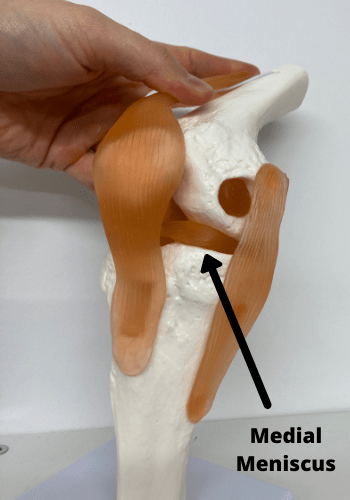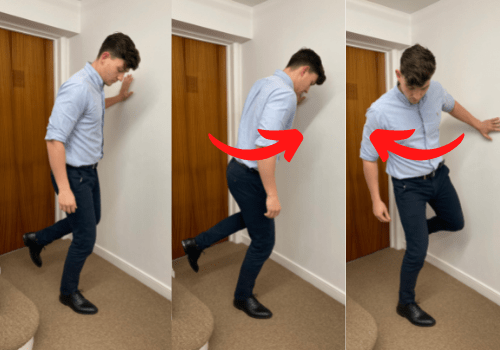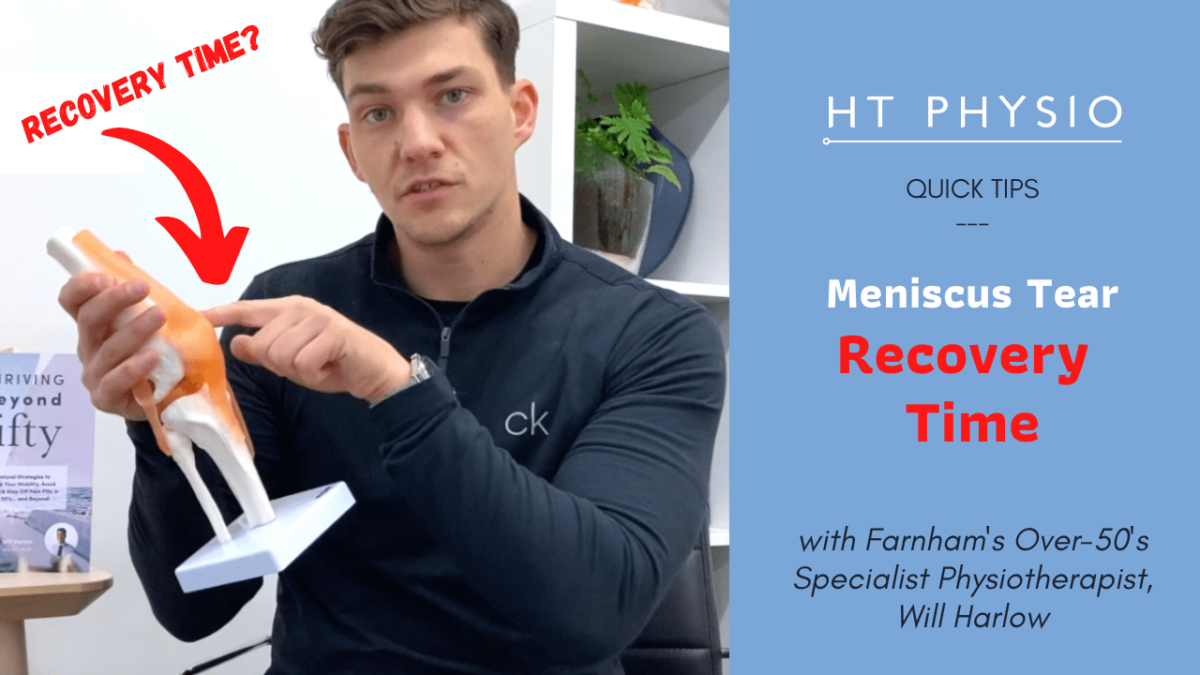In this article, I am going to give you all the information you need to know about meniscus injuries and reveal how long to allow for meniscus tear recovery time.
Here is what we will be covering in this article:
- What is a meniscus tear in the knee?
- What is an acute meniscus tear?
- What is a degenerative meniscus tear?
- Where is meniscus tear pain?
- Meniscus tear signs and symptoms
- Test for meniscus tear
- Will a meniscus tear heal on its own?
- Meniscus tear recovery time
- How to help a meniscus tear at home
Before we dive in, the following should not be regarded as medical advice and should be used for informational purposes only. Full terms here.
What is a meniscus tear in the knee?
A meniscus tear is a common injury that affects a structure inside the knee called the meniscus.
In fact there are two menisci in our knees: one on the medial side (inside of the knee) and one on the lateral side (outside of the knee). We call these the medial meniscus and lateral meniscus.


The meniscus is a very important structure. It is made of tough fibrocartilage and acts as a shock absorber inside the knee.
When we walk and stand, forces travel through the tibia (shin bone) into the femur (thigh bone). The meniscus helps to cushion this force and protect the other structures within the knee.
The meniscus is tightly bound down to the top of the tibia. This means that it can act as a very effective shock absorber but it is vulnerable to twisting due to it being so tightly attached.
Luckily, our knees are only designed to move forwards and backwards. Most of the time, the meniscus does not have to cope with much twisting.
However, in some unfortunate cases a twist can occur which can lead to a meniscus tear in the knee.
We call this an acute meniscus tear.
Acute meniscus tear
An acute meniscus tear is a type of meniscus tear that occurs usually due to a specific injury.
An acute meniscus tear often involves a twist or a fall which makes the knee move in a way that it was not designed to.
Because the knee is not designed to twist and the meniscus is tightly attached, sudden twists can tear the meniscus.
Anyone can suffer from an acute meniscus tear but they are most common between the ages of 30 and 50.
An acute meniscus tear is also a common sports injury. Sports such as football, rugby and hockey are all common settings for an acute meniscus tear.
The common signs of an acute meniscus tear are:
- Pain along the inside or outside joint line of the knee (where the two bones meet)
- Locking of the knee – which means the knee getting “locked” in a position, often where it must be manually manipulated to be able to move again
- Giving way of the knee
- Weakness around the knee joint
- Swelling around the inside or outside of the knee joint
Over the age of fifty, an acute meniscus tear becomes less likely.
This is because as we age, the meniscus dries out and loses its turgidity.
This means that, although is becomes less effective as a shock absorber with age, it also becomes less sensitive to twisting and less likely to suffer an acute meniscus tear.
However, there is a different type of meniscus injury that affects those over fifty more commonly.
This is called a degenerative meniscus tear:
Degenerative meniscus tear
A degenerative meniscus tear is an injury that occurs over time, rather than as a result of one specific incident.
As we age, the meniscus becomes drier and more brittle, developing damage and micro-tears which often occur along with arthritis.
This sounds terrible, but for most people this is unnoticeable.
However, for unknown reasons, for many people these degenerative meniscus tears can cause pain and stiffness which presents similarly to arthritis in the knee.
The symptoms of a degenerative meniscus tear are usually less severe – but they can be more persistent.
The common signs of a degenerative meniscus tear are the following:
- Pain along the inside or outside knee joint line which started over time
- Weakness around the knee joint
- Giving way of the knee
- Difficulty turning or twisting when weight bearing
- Pain when crossing the legs
- Difficulty and pain when swimming
- Pain when walking
A degenerative meniscus tear is most likely to affect those over the age of fifty and often plagues those who played a lot of sport in their younger years.
Although many clinicians regard degenerative meniscus tears as a problem that cannot be treated except for surgery, we often get fantastic results at our clinic when it comes to treating patients with this problem.
Where is meniscus tear pain?
Meniscus tear pain is one of the tell-tale signs of a meniscus injury.
The location of the pain will depend on whether the meniscus tear is in the medial meniscus or the lateral meniscus.
A tear in the medial meniscus is more common and accounts for 80% of meniscus injuries. This is because the medial meniscus is more tightly bound down than its relative.
Medial meniscus tear pain is usually felt directly over the inner joint line, as demonstrated in the picture below:

Medial meniscus tear pain can often be tested by touching the medial joint line. If this feels sore and tender, it is often a sign of a meniscus tear.
Lateral meniscus tear pain is usually felt directly over the outer joint line, as demonstrated in the picture below:

Again, you can try palpating the lateral joint line and watching for tenderness as a sign of a lateral meniscus tear.
Meniscus tear signs
Here are the common meniscus tear symptoms that can be present for both medial meniscus tears and lateral meniscus tears:
- In the case of a medial meniscus tear, pain on the medial joint line (inner knee)
- In the case of a lateral meniscus tear, pain on the lateral joint line (outer knee)
- Giving way of the knee
- Tenderness to touch the inner or outer joint line
- Locking of the knee
- Weakness around the knee
- Swelling along the joint line
- Inability to weight bear after initial injury
- Pain when weight-bearing
- Pain on twisting the knee
- Pain when swimming, especially breaststroke
- Inability to fully bend or straighten the knee
- Pain in the knee at night, particularly when lying on your side
- Difficulty resting the cover of the duvet on your knee
Test for meniscus tear
One of the best tests (being the most specific and valid test we have) is feeling along the joint line of the knee and watching for tenderness.
This is the most reliable test we have for a meniscus tear and it is surprisingly accurate.
This test can help you differentiate between a degenerative meniscus tear and arthritis, because the joint line usually is NOT painful to touch if it is just arthritis affecting your knee.
Watch the video below for guidance on this test:
Another test that can help to identify a meniscus tear is a single-leg stand with a gentle twist.
This is called the Thessaly test and is demonstrated below.
This test should not be performed to self-diagnose any injury but may be done in the physiotherapist’s office to demonstrate a meniscus tear.

2. Keeping your foot planted, slowly turn your body to the left
3. Keeping your foot planted, slowly turn your body to the right
4. The test is positive if there is pain over the joint line
Will a meniscus tear heal on its own?
Contrary to what many doctors will tell you, meniscus tears CAN heal without surgery.
When thinking about whether a meniscus tear will heal on its own, we need to assume that the person is doing all the right things to help the process.
Here are the things that must be ensured to encourage more rapid healing of a meniscus tear:
- Allow the initial pain to settle with rest, ice, compression and elevation (RICE) – you can find a guide to using ice or heat for knee injuries here.
- Prevent any twisting – including crossing legs, breaststroke swimming, twisting when on feet etc.
- Avoid sport until the pain subsides and your strength returns.
- Seek to improve the strength of the muscles, flexibility of the lower limb and mobility of the knee to speed up healing. You can find a complete guide for doing that here.
- Continue to walk as normal in most cases as this should be good for healing.
- Avoid running – try walking or cycling instead.
- Do not try to move objects with your foot, hold doors open with your foot or kick anything during the healing process.
For 80% of people, meniscus tears DO heal on their own. Let’s have a look at meniscus tear recovery time below:
Meniscus tear recovery time
In general, for an acute meniscus tear, the entire healing process might take 9 months for 80% of people.
However, this can be sped up through optimising recovery using the strategies above and below, including the use of our complete guide to maximising knee health here.
Of course, not everyone will get better naturally (depending on the size and shape of the meniscus tear) and some will need surgery.
However, a natural meniscus tear recovery time of nine months without surgery is the average, so some people will recover quicker and some will take longer.
The reason meniscus tears take so long to heal is because the meniscus has a very poor blood supply.
In order for healing to occur, blood must diffuse in and out of the knee via the bones of the knee joint, which takes a lot longer than it would if there was a direct blood vessel.
For a degenerative meniscus tear, healing will not occur in the same fashion as in an acute meniscal tear.
Luckily, it is still possible to get a degenerative meniscus tear better – but this usually occurs by optimising the function of the knee which encourages symptoms to disappear, even if the underlying degeneration does not change dramatically.
This is where the controversy in meniscus tear recovery time exists: many people think that because a degenerative meniscus tear does not heal back to normal that it will always remain painful.
Luckily, this is simply not true and recovery is something that we witness at our practice on a daily basis.
Meniscus tear healing time can be significantly reduced through a proper protocol that ensures improvements in mobility, flexibility and strength of the area that surrounds the knee joint.
Here is the typical meniscus tear healing time that we observe at our practice:
| Acute Meniscus Tear | Degenerative Meniscus Tear | |
| Watch-and-wait approach (do nothing, allow healing to occur naturally) | For 80%: 6-9 months to heal For 20%: Surgery required | For 80%: 6-9 months for the pain to settle, risk of recurrence For 20%: Surgery required |
| Active rehabilitation (following our protocol) | A 60-100% improvement can usually be attained in 3-4 months for 80% of people. | A 40-100% improvement can usually be attained in 4-6 months for 80% of people. |
| Meniscus repair surgery | 9 months rehabilitation | N/A |
| Meniscectomy | 6-8 weeks (but risks of accelerated degeneration later in life) | 6-8 weeks (but risks of accelerated degeneration later in life) |
For the above table, we looked at four scenarios:
- Watch-and-wait
- Active rehabilitation
- Meniscus repair surgery
- Meniscectomy.
Please note that the timescales given are the average and may not apply to all.
Meniscus repair surgery requires the meniscus to be in good condition which is why it is rarely offered to people who have a degenerative meniscus.
A meniscectomy is a quick way to gain an initial improvement… but has been shown to accelerate the process of arthritis.
Is a meniscus tear serious?
A meniscus tear is not thought of as “serious” in terms of threat to life, but it may well threaten mobility, independence and quality of life.
In this way, we tend to think of meniscus tears as significant and emphasise with patients who suffer from them.
We almost always recommend some kind of rehabilitation for a meniscus injury: either to speed up healing, reduce pain, improve mobility or improve the chances of a successful operation if needed.
How to help a meniscus tear at home
Meniscus tears can be helped at home through following the principles listed above, which are:
- Allow the initial pain to settle with rest, ice, compression and elevation (RICE) – you can find a guide to using ice or heat for knee injuries here.
- Prevent any twisting – including crossing legs, breaststroke swimming, twisting when on feet etc.
- Avoid sport until the pain subsides and your strength returns.
- Seek to improve the strength of the muscles, flexibility of the lower limb and mobility of the knee to speed up healing. You can find a complete guide for doing that here.
- Continue to walk as normal in most cases as this should be good for healing.
- Avoid running – try walking or cycling instead.
- Do not try to move objects with your foot, hold doors open with your foot or kick anything during the healing process.
Our forthcoming Optimal Knee Health Programme is a home course that we designed to help people improve the health of their knees.
The programme is very similar to the graduated rehabilitation that we take our patients with meniscus injuries through to promote a full recovery.
You can read more about the programme here.
Thank you very much for reading and I hope you enjoyed this article.
If you did, please feel free to leave a comment below with any questions.
About Will Harlow

Will Harlow is a chartered physiotherapist and practice owner from Surrey. He founded his practice, HT Physio, in 2018 and specialises in helping over-fifties to overcome painful problems, regain mobility and independence, and avoid surgery. He published his book Thriving Beyond Fifty in May 2020, which has gone on to sell hundreds of copies and gain plaudits worldwide.


3 replies on “Meniscus Tear Recovery Time – Can a meniscus tear heal without surgery? (2022 Guide)”
Excellent, thank you. Clear and plausible, accords with my own experience, especially with regard to healing time. Good to read a natural response to injury without extreme bias of view. Well done, good luck!
Thank you, your article is very informative. It’s hard to function normally after a degenerative meniscus tear, and a constant fear of re-injury is overwhelming.
Thank you! This has been so encouraging. I’m a 62 year old yoga instructor and avid hiker. I have a medial horizontal and radial tear from a hike 3 months ago and was told no healing is likely despite my dedicated rehab exercises, and that the significant pain will come and go from now on indefinitely. I have been beside myself with the prospect of no real improvement possible and dosing on anti-inflammatory drugs each time I hike. Thanks for letting me know the process of rehab might show an improvement over a few more months. Now I have light to work towards. I’m very grateful.